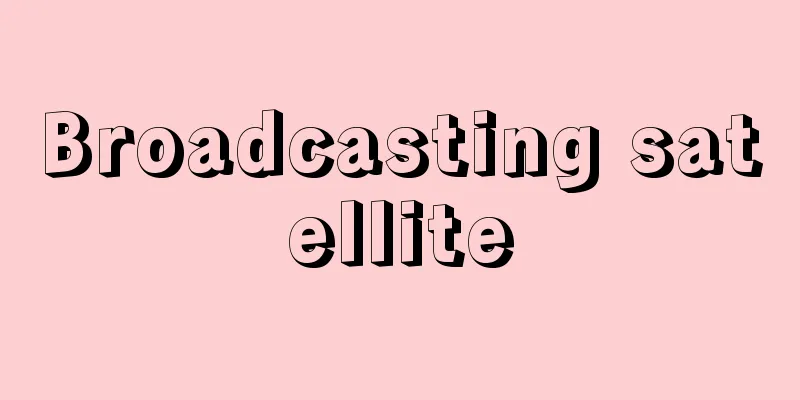Broadcasting satellite

|
Satellite broadcasting is a system in which television transmission waves sent from terrestrial broadcasting stations are relayed by artificial satellites so that they can be received directly by the antennas of each household. A satellite relays the television transmission waves (video and audio signals) for this purpose. The basic function of a broadcasting satellite is the same as that of a communication satellite. It receives radio waves transmitted from the ground with an onboard repeater (transponder), converts them to a different frequency, and retransmits them to the ground. Broadcasting satellites use the Ku band (12 to 18 gigahertz). This frequency band has a wider transmission bandwidth than terrestrial broadcasting, allowing for higher quality television broadcasting. On the other hand, during heavy rainfall, the signal is attenuated by the rain and the image becomes distorted. Reception is not limited to ordinary homes on the ground, but is also possible on moving objects such as trains and ships. Placing a broadcasting satellite in a geostationary orbit is much more efficient than placing many relay stations on the ground. Broadcasting satellites increase the transmission power of the satellite so that they can be received by small antennas in ordinary homes, and control the broadcast area with a shaped beam antenna that narrows the broadcast area (preventing the leakage of broadcast waves, known as spillover). In Japan, technological development and demonstration experiments were carried out using experimental geostationary broadcasting satellites "Yuri" (1978), "Yuri 2-a" (1984), and "Yuri 2-b" (1986), and the world's first full-scale satellite broadcasting began in 1989 (Heisei 1). After that, "Yuri 3-a" (1990), "Yuri 3-b" (1991), and "Yuri 4" (1997) were launched one after another, and satellite broadcasting in Japan was firmly established. BS broadcasting consists of BS (analog) broadcasting, which began in 1989, and BS digital broadcasting, which began in 2000 (Heisei 12). The analog system was discontinued in July 2011 except for some areas, and the system was replaced by the digital system. As of 2016, three satellites, BSAT-3a, BSAT-3b, and BSAT-3c, are operating in geostationary orbit at 110 degrees east longitude, and satellite core broadcasting is being carried out. The next broadcasting satellite, BSAT-4a, will be launched in 2017. Test broadcasts of high-definition broadcasting services, such as 4K (images with four times the pixel count of full HD) and 8K, were carried out in 2015, and as of 2016, three ultra-high definition television programs (4K) and 156 high definition television programs are being broadcast. [Takashi Moriyama January 19, 2017] "Artificial Satellites - From Rockets to Broadcast Satellites" by Nagai Yutaka (1991, Denki Shoin)" ▽ "All About Satellites - The Progress and Technology of Satellite Communications Such as BS and CS" revised edition by Harada Masumi (1993, Denpa Shimbunsha)" ▽ "Basic Knowledge of Broadcast Satellites - With a Focus on BS Digital Broadcasting" edited by Endo Keiji and Izumi Takehiro (2001, Kenrokukan Publishing)" ▽ "A New Introduction to Broadcasting - Exploring the Systems in the Digital Era" by Kataoka Toshio (2001, NHK Publishing)" [Reference] | | | |The broadcasting satellite (BS-3a) was launched on August 28, 1990. It continued to provide satellite broadcasting together with the backup satellite "Yuri 3b" that was launched afterwards, and ceased operation in April 1998. ©JAXA "> Broadcasting satellite "Yuri 3a" (conceptual drawing) The size of the main body is approximately 1.3m x 1.6m x 3.2m, and the weight is approximately 550kg. It is equipped with a 3-channel broadcast repeater and a broadband repeater. ©JAXA "> Broadcasting satellite "Yuri 3a" Source: Shogakukan Encyclopedia Nipponica About Encyclopedia Nipponica Information | Legend |
|
地上の放送局から発信されたテレビ送信波を人工衛星が中継し、これを直接各家庭のアンテナで受信できるような方式を衛星放送といい、このためのテレビ送信波(映像信号と音声信号)を中継する衛星。 放送衛星の基本的な機能は通信衛星と同様で、搭載した中継器(トランスポンダー)で地上から送信した電波を一度受信したのち、別の周波数に変換して地上に向けて再送信する。放送衛星ではKuバンド(12~18ギガヘルツ)を利用する。この周波数帯は地上放送に比べて伝送帯域幅が広くとれるので、より高品質なテレビ放送が可能になる。一方、強い雨が降っている時などは降雨による減衰を受け、映像が乱れる。受信は地上の一般家庭に限らず、鉄道や船舶などの移動体でも可能である。放送衛星を静止軌道に置くことで、地上に多くの中継局を設置するよりもはるかに効率的になる。放送衛星は一般家庭の小型アンテナでも受信可能なように、衛星側の送信電力を高くし、放送エリアを絞る成形ビームアンテナで放送域を制御(スピルオーバーといわれる放送波の漏洩(ろうえい)を防止)する。 日本では実験用静止放送衛星「ゆり」(1978)、「ゆり2号a」(1984)、「ゆり2号b」(1986)により技術開発と実証実験が行われ、1989年(平成1)から世界初の本格的な衛星放送が開始された。その後、「ゆり3号a」(1990)、「ゆり3号b」(1991)、「ゆり4号」(1997)が相次いで打ち上げられ、日本における衛星放送は確固たるものとなった。BS放送には、1989年に本放送が開始されたBS(アナログ)放送と、2000年(平成12)に本放送が開始されたBSデジタル放送がある。アナログ方式は2011年7月に一部の地域を除いて廃止され、デジタル方式に移行した。2016年時点では、東経110度の静止軌道に、BSAT(ビーサット)-3a、BSAT-3b、BSAT-3cの3機が運用され、衛星基幹放送が行われている。2017年には次期放送衛星BSAT-4aが打ち上げられる。4K(フルハイビジョンの4倍の画素数の映像)や8Kという高精細な放送サービスは、2015年に試験放送が行われ、2016年時点で3番組の超高精細度テレビジョン放送(4K)、156番組の高精細度テレビジョン放送が行われている。 [森山 隆 2017年1月19日] 『永井裕著『人工衛星――ロケットから放送衛星まで』(1991・電気書院)』▽『原田益水著『衛星のすべて――BS、CSなど衛星通信の歩みと技術』改訂版(1993・電波新聞社)』▽『遠藤敬二・泉武博監修『放送衛星の基礎知識――BSデジタル放送を中心として』(2001・兼六館出版)』▽『片岡俊夫著『新・放送概論――デジタル時代の制度をさぐる』(2001・日本放送出版協会)』 [参照項目] | | | |1990年(平成2)8月28日に打ち上げられた放送衛星(BS-3a)。その後に予備機として打ち上げられた「ゆり3号b」とともに衛星放送の提供を続け、1998年4月に運用を停止した©JAXA"> 放送衛星「ゆり3号a」(イメージ図) 本体の大きさは約1.3m×1.6m×3.2m、重量は約550kg。3チャンネルの放送用中継器や広帯域中継器などを搭載した©JAXA"> 放送衛星「ゆり3号a」 出典 小学館 日本大百科全書(ニッポニカ)日本大百科全書(ニッポニカ)について 情報 | 凡例 |
Recommend
Kintoki (car bream) - Kintoki
...A marine fish of the Perciformes family (illus...
Sperry, RW (English spelling)
...Recently, recording of single neuron activity ...
Murder of the King - Ousatsugai
...In the broad sense, it refers to any illegal k...
Urasaki Kengyo
?-? A jiuta and koto musician from the late Edo p...
Naematoloma fasciculare (English spelling)
…[Rokuya Imaseki]. . … *Some of the terminology t...
Bacteriology - saikkingaku (English spelling) bacteriology
A branch of biology that deals with bacteria. The...
Omotesenke Fuhakuryu
A school of tea ceremony founded by Kawakami Soju...
Onjin Byodo Monument - Onjin Byodo Monument
...The temple was granted 100 koku of land and el...
Gibbs, JD - Gibbs
…Westinghouse saw the future potential of AC tech...
Yasumasa - Koushou
The Japanese era name (nengo). It was the era name...
Pearson Report
This report was submitted to the World Bank Annual...
LME - Large Millionaire
London Metal Exchange: An exchange that mainly tra...
Nanshi - Nanshi
An official history of China. One of the 25 histor...
Echo (English spelling)
In Greek mythology, she is an echo-female spirit. ...
Aganooki Oil and Gas Field - Aganooki Gas Field
Discovered in 1972, this is Japan's first full...








![Konkou [town] - Konkou](/upload/images/67cba060570cd.webp)
